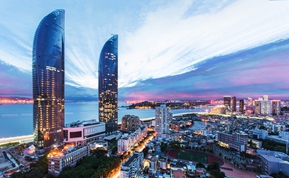Tourism thrives in Fujian during National Day holiday
Statistics from the Fujian Provincial Tourism Bureau have shown that, during the 2014 National Day holiday, or "Golden Week” holiday, Fujian province received a total of 1.5 million tourists, bringing nearly 10 billion yuan ($1.6 billion) in tourism revenue to the province, a 20.1 percent year-on-year increase.
Specifically, 22 major tourist attractions in Fujian province have attracted 5.48 million visitors, a 7.2 percent year-on-year increase. The province saw 231 million yuan in ticket revenue, a marked 11.2 percent growth this year.
Statistics show that per capita consumption during the first week of October in Fujian province reached 643.66 yuan. Five major cities, namely Fuzhou, Xiamen, Zhangzhou, Quanzhou and Longyan, have each received over 1 billion yuan in profits .
According to the Fujian Provincial Tourism Bureau, new patterns of traveling, including eco tours, hot spring tours and countryside tours, are gaining more and more popularity.
During the holiday, many people came to seek relaxation in Fuzhou, capital of Fujian province, which is popular for hot springs. From October 1 to 6, the hotel occupancy rate in Fuzhou’s main hot spring resorts reached 100 percent, with Gui’an hot spring resort alone receiving 180,000 visitors.
In addition, eco-tourism scenic spots in Fujian, including Qingyun Mountain in Yongtai county, Dajinhu Lake in Taining, Guanzhai Mountain in Liancheng county, and Taimu Mountain in Fuding city also saw great popularity during the holiday. They received a total of 4.3 million visitors, a 6.8 percent year-on-year increase.
In terms of transportation, the two main ways of traveling were high speed trains and self-driving. Figures have shown that on October 2, the number of visitors who traveled by high-speed trains to Zhangzhou and Quanzhou surged 83.6 percent, and almost all visitors choose self-traveling to Taimushan Mountain during the holiday.
By China Daily Fujian Bureau
Why Xiamen
-

Xiamen is one of the most economically competitive cities in China and was one of the first Special Economic Zones on the Chinese mainland. As a vice-provincial city independently listed on the State development plan, it has provincial-level authority in economic administration and local legislative power. In 2010, the Xiamen SEZ was expanded to cover the entire municipality. Today, Xiamen is a modern and international port city.
